Chapter 23 – Entomophagy: You Eat What???

OK, let’s get this out of the way. Yes, there is a “yuck” factor when it comes to eating insects—especially in the U.S. But, it’s time to get over it. A lot of the world engages in entomophagy or the eating of insects on a regular basis. Only in the Western world is there a stern and abiding revulsion at the idea. At a minimum, we should take the opportunity to learn about why the rest of the world is not like us. In the process, we might discover something about how other people live and how we might benefit from their practices.
We really are obliged to consider entomophagy when so lofty an organization as the Food And Agriculture Administration (FAO), part of the United Nations, puts out a 200-page document outlining the benefits of entomophagy (Figure 23.1). Yes, serious people are taking this seriously. And even if you’re not inclined to run out and get a beetle burger, you should at least be prepared to consider that this might not only be a realistic option, but an attractive one in many respects.
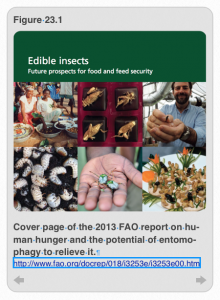
It will not be a surprise to you, since you have already read through the previous chapters in this book that there is a lot of evidence of entomophagy among humans that spans time periods from ancient times to present. How do we know that ancient humans were eating insects? Well, we have human coprolites—fossilized human feces—with grasshopper, beetle, wasp, ant, and termite fragments in them, suggesting that ancient humans looked at the world as a vast insect smorgasbord. And of course, many of you have already forked over large sums of cash to eat crabs, lobsters, and shrimp—all of which are arthropods. They are so delicious! Why doesn’t this view extend to their insect cousins? At a minimum, this is something to ponder. Finally, many cultures around the world today are actively engaged in entomophagy by choice. So what makes Western society so different and why might we want to consider broadening our perspective?
Global Food Insecurity
Let’s start with a broad overview. According to a 2012 report by the aforementioned FAO, 870 million people or 15% of the human population suffered from chronic food insecurity meaning that they were chronically undernourished in 2010–2012. Unfortunately, the biggest gains in correcting this problem took place prior to 2007. Since then, efforts to reduce food insecurity have been less effective. Trends in world population growth, which we will examine in a moment, make resolution of this problem imperative if we are to stem the tide of misery caused by hunger. In so doing, we are fighting biology in the sense that 90% of all energy is lost to heat energy at every trophic link, a phenomenon which we will also examine in more detail later in this chapter.
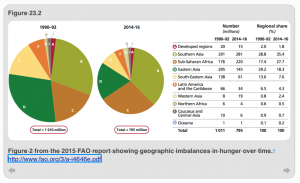
The distribution of food insecurity around the globe is very uneven (Figure 23.2). According to the 2015 FAO report, we’ve gone from 1,010 million chronically hungry people in 1990–1992 to 795 million hungry people in 2014-2016. That’s the good news. However, the rate of reducing hunger is decreasing and the population is growing. Even more dire is that fact that while the number of undernourished people in all of Asia except for Western Asia is going down, the rate in Sub-Saharan Africa is going up. There, hunger rates are increasing at about 2% per year. Much of the recent increases in hunger or lowering in rates of reduction is due to the global economic recession that began in 2008, attendant price increases and disparities in natural resources. Further attempts to reduce hunger must be broad-reaching, able to take advantage of local resources and adapted to regional economic differences
The problem is urgent. Every second on this planet, five people are born and two people die. This is a net gain of three human beings per second. In Figure 23.3, you see the world’s distribution of humans as of 2008. The darker the color is, the greater the number of people per hectare. If we can’t feed the current population, what does it mean to add 3 people to the planet every second?
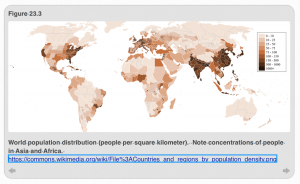
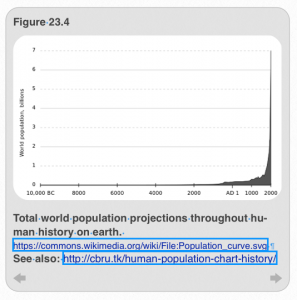
To put this in some perspective, in the year AD 1, the human population around the world was estimated at 330 million (Figure 23.4). Note the slight dip in world population during the time of The Black Death. Throughout most of human history, the rate of increase of the human population was linear until about the year 1900. Then, the growth rate began to grow exponentially. The human population is projected to level off around 2050. This could be due to voluntary population restriction or lack of resources. To a large extent, the choice is ours.
A consistent demographic pattern is that when economic growth in a region is good, the birth rate goes down. It costs more to support a child in Western countries but more importantly, birth rates go down when education and economic opportunities are more available. Accordingly, when women have control of their fertility and are able to acquire an education, they have fewer children. Therefore the birth rate is fairly low in western Europe and Japan while it is particularly high in Sub-Saharan Africa, Asia and Latin America. It is also projected that 400 million people will starve or be severely undernourished in these regions in 2030.
Energy Flow in Food Webs
The disparity between human population growth and food resources is dire in developing countries. Social instability in vast areas of the world has the potential to destabilize Western countries where food is currently plentiful. The question is: what can we do about it? The first piece of this is to fully understand the nature of the problem. In this instance, humans cannot be considered to be separate from the world in which we live. We are all part of the big one-way flow of energy around the world. All energy on earth ultimately derives from the sun. Energy given off by the sun is captured by plants and used to make sugars and proteins. Ecologically, plants are, therefore, considered primary producers. Plants, in turn, are eaten by herbivores (primary consumers) and they, in turn, are eaten by meat eaters, or carnivores (secondary consumers).
Ecologically, this arrangement is quite elegant. And while this is not a physiology course, it is relevant to at least point out the interdependency that all living systems have upon each other. In Figure 23.5, you see a graphic that puts it very simply. All living systems on earth are ultimately powered by the sun whose radiation is captured by plants and used to make sugar (glucose). But in the process of producing that glucose the plant gives off a waste product, namely, oxygen gas. The latter is a substance that is very much needed by the consumers in order to live. First- and second-level consumers eat plants and each other. When they die, their biomass gets recycled by microbes and invertebrates and their nutrients are returned to the food chain.
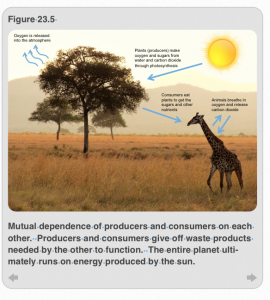
As the 18th century poet Francis Thompson so eloquently put it, “All things to each other linked are; Thou cans’t not stir a flower without troubling a star.” And because we are all linked, perturbations in one part of the system will affect everything else. We have to understand and be sensitive to those interplays if we are to adjust our strategies for feeding the world in ways, which might make a difference. To proceed in ignorance of the laws of nature that govern energy relationships is sheer folly.
From the ingestion of plants and animals, the consumers break down the sugars and other nutrients to make ATP (adenosine triphosphate), the biologically useable form of energy to run their cells. Another way to think of this is ATP is the cellular energy currency. Oxygen is critical to these reactions, without which metabolism of large organisms would not be possible. Like plants, consumers also give off a waste product that primary producers (plants) absolutely require in order to survive. This waste product is carbon dioxide or CO2. Plants use the CO2 given off by consumers as a raw ingredient to make sugar or glucose. So, producers and consumers are joined in this dance of mutual dependence in which each generates a waste product that the other needs to survive. “All things to each other linked are.”
You now have a basic understanding of how energy originates in our ecosystems and where it goes. We say that the flow of energy through the ecosystem is unidirectional. That is, energy flow only goes in one direction. Because the flow of energy is not completely efficient, much of the biomass consumed at each level is not converted into new biomass but is instead given off as heat. When all of the living organisms are done transforming biomass, the remnants of all of these processes are contained in the inorganic pool of nutrients. Unlike energy, inorganic nutrients can be recycled and, in essence, flow back to produces where they begin the cycle again.
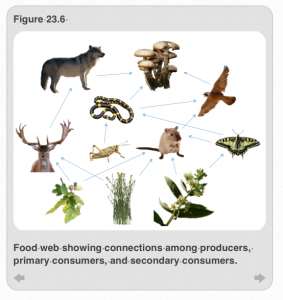
Figure 23.6 shows a complex food web where the relationships between multiple kinds of producers and consumers are identified. This is a good time to be more explicit about the reality that energy transfer between trophic levels is not 100% efficient. Not even close to it. Energy is lost at every trophic link for several reasons. First, not everything in lower trophic levels gets eaten. When those organisms die, their biomass goes directly to the decomposers. Second, not everything that is eaten gets digested. All organisms eliminate undigested material as feces or guano or some other waste product. Third, as you know, a lot of energy is lost as heat. Ecologists estimate that for each trophic link, 90% of the available energy is lost, meaning that only 10% of the energy moves to the next trophic level. Thus, the more trophic links there are in a food chain, the greater the loss of biomass to nonproductive ends. This is why it is much more ecologically efficient for humans to eat broccoli (one trophic link) than cows (two trophic links).
And, of course, we need other things to make the ecosystem run. We humans wouldn’t last more than 48 hours if we didn’t have water. All critters, whether primary producers or any level of consumer, need water. As is the case with biomass, the more trophic levels there are, the more water will be needed to produce a given amount of biomass (Figure 23.7). So, to generate one pound of beef, we need 1,850 gallons of water because there are two trophic links to get from grass to a cow. In contrast, we need only 39 gallons of water to make one pound of vegetable matter. On a global scale, this leads to a mismatch between available resources and ongoing needs. It is particularly evident for humans whose population levels continue to grow, creating large increases in demand for food and water to grow the food especially in developing nations.
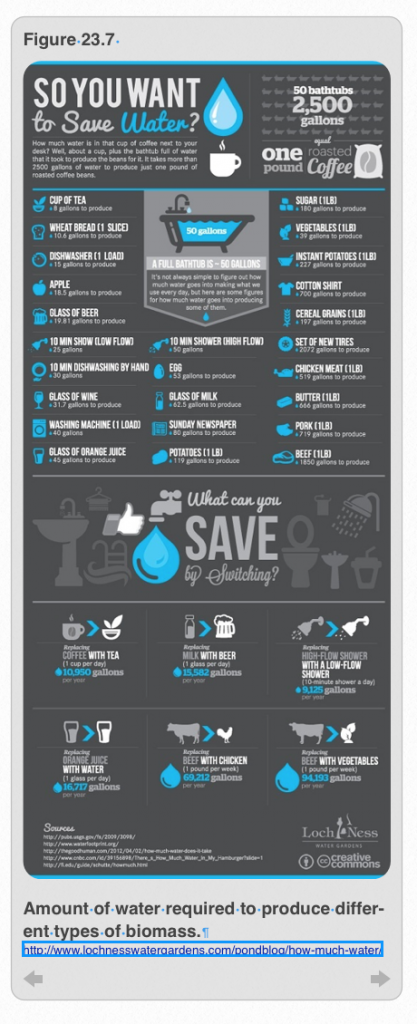
We might also take a minute to describe the kinds of nutrition needed to support humans. In particular, we have a need for protein, which you probably already know, consists of building blocks called amino acids (review Sidebar 14.1 for more information). There are 20 amino acids that make up the proteins we require to be healthy. Nine of these amino acids are called “essential” because we cannot make them ourselves. As a consequence, we have to eat food that contains them or we won’t be properly nourished. If we take the essential amino acid lysine, it is found only in small amounts in animal protein. Thus, we will not have a healthy diet if we eat only meat. If, however, we eat a diet rich in legumes (beans), we will get lots of lysine. This reality, in addition to the ecological ones, is a great reason to make sure your diet consists of lots of plant material.
Benefits of Entomophagy
And these considerations lead us to ask whether turning to a diet that has insects in it might be a legitimate way for human beings to feed our burgeoning population. If we were to augment our diet with insects, would we be better off nutritionally and ecologically? These are the important questions.
Let us first go back to the question of why we typically don’t eat insects in Western culture. We already know that ancient humans readily ate insects. In fact, the Bible tells us which ones we can eat. One entomophagy enthusiast even composed a poem to celebrate the eating of insects:
“For our best and daintiest cheer
Through the bright half of the year
Is but acorns, onions, peas
Okras, lupines, radishes
Vetches, wild pears, nine or ten
With a locust now and then.”
We also know that our simian cousins, such as the chimpanzee, are big insect eaters. Video 23.1 shows a chimpanzee fishing for termites. You can clearly see the advanced skill occasioned by creating a tool (a sharpened stick) and the manual skill it would take to find and skewer a termite in order to eat it. This begs the question: how much did entomophagy contribute to our evolutionary trajectory? While we cannot be entirely sure, we know that the increase in brain size that occurred in our early human relatives was literally fueled by a higher-protein diet, and it is highly likely that our ancestors acquired at least some of that protein from eating lots of insects along with fish, crab, shrimp and mammals.
Furthermore, although shocking and offensive to some, the truth is that Americans already eat a fair amount of insects. The Food and Drug Administration (FDA) prescribes the amount of insect biomass we can have in human food. These data are published in a government document that details the maximum number of insect adults, eggs, immatures, frass (yep, frass, also known as insect poop), or fragments that are permissible in food intended for human consumption. Are you horrified?
While reading the document is about as interesting as reading the phone book, here a few highlights to give you the flavor:
• For every 100 g of brussel sprouts, there can be no more than 40 aphids or equivalent in thrips. (What do you suppose are thrips-equivalents??)
• For every half cup of raisins, there can be no more than 10 insects or equivalents in pieces AND 35 fruit fly eggs.
• For every peanut butter sandwich, by law, there can be no more than 56 insect parts.
So before you swear off eating brussel sprouts, raisins and peanut butter, know that there is no harm other than the psychological harm of knowing that you’re eating insects and, of course, the benefit of increased protein and fiber content.
Additionally, there are more reasons to eat intentionally insects. For instance, biochemically, insect tissue is high in protein (30–80% by fresh weight) and contains all essential amino acids, including lysine which is absent or low from most vertebrate meat. Further, insect tissue is relatively low in fat, especially the kind that is bad for your heart. Also, insects are rich in vitamins and minerals, so if you eat an insect-rich diet you don’t need to take a multivitamin. If we also take into account the ecological reasons for preferring insects to mammals and poultry, we find that there is a high energy of conversion. What does this mean? For every 100 pounds of grain consumed, we get 38–40 pounds of chicken, 10 pounds of cow, and 19–31 pounds of tent caterpillars. So, if you want to eat in an ecologically sensitive manner, you’d be better off saying no to beef and yes to either chicken or caterpillars.
While entomophagy is not generally practiced in the U.S. today, there was a time when it was fairly common—especially west of the Mississippi. This was particularly the case when the climate was less favorable to the production of agricultural crops. Native Americans were well-acquainted with the joys of entomophagy and would even stage locust drives to round up large, edible numbers of them. Similarly, the Paiutes had good recipes for smoking pine caterpillars and the Cheyenne were known to eat a variety of insects.
And finally the coup de gras: most of us readily eat crayfish, shrimp, lobsters and crabs—all of which are arthropods. Other than being bigger and meatier than insects, what is the essential difference? Why shouldn’t we eat insects if we are eating shrimp?
From time to time, erstwhile entomologists have tried to introduce insects into haute cuisine. For instance, C.V. Riley, head of the U.S. Entomological Commission at the time of the great locust plague in 1873–1876 tried to entice members of congress with a several course meal prepared with locusts. Congress was not amused.
And of course, one final reason for not eating bugs is that they are small and you’d have to amass a bunch of them in order to make a meal. But, various cultures both within and outside the U.S. have dealt with this problem, so this objection, too, seems silly. Plus there are occasions on which bugs do occur in great numbers in the U.S. Think about the annual invasion of mayflies in the Great Lakes or the eruption of the periodical cicadas. You could feed a village with these critters! As insects provide the complete nutritional package as they are chuck full of vitamins, minerals carbohydrates, fats and proteins, and given the reality that grasshoppers are higher in protein and lower in fat that cows (Table 23.1), you really ought to eat grasshoppers if you want the best nutrition. People around the world do just that.
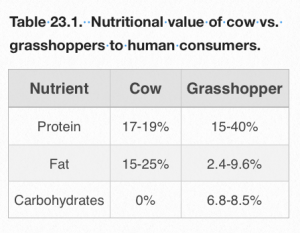
Entomophagy Around the World
In Figure 23.8a, b, you see two kinds of insects that are regular fare for Australian Aboriginals. Honey pot ants are gorged with food by worker ants until the abdomina (gasters) of the honey pot ants are large and swollen. Then, the honey pot ants act as living larders for the other ants in the colony, which extract sugary syrup from them. This is not lost on humans who eat them as a highly prized dessert item.
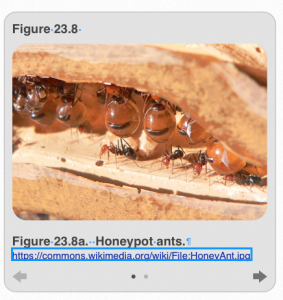
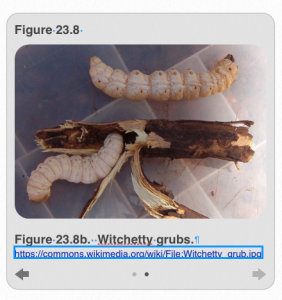
In contrast, the witchetty grubs are the larvae of several different moths. They are large (the size of a man’s finger or larger) and white and have a high protein content for which they are highly valued—especially in desert environments where they serve as a staple for aboriginal women and children. They can be eaten raw or cooked over hot ashes.
Entomophagy in Africa is rich and varied. It would certainly include the Mopane worm (Figure 23.9), which is not a worm but the larva of the Emperor Moth. It is considered a delicacy by many and a lowly bush food by others. But all agree that it is highly nutritious. At the Boma Restaurant at Victoria Falls Safari Lodge, you can get them cooked with tomatoes, onions and garlic. Wander into a local market and you’re likely to find them dried and bagged. Either way, a very delicious nutritious treat awaits you!
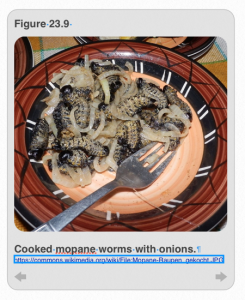
This Cambodian woman presents a platter of cicadas (Figure 23.10), fried to crispy goodness and ready to eat. As a precaution, the FAO recommends that you remove the legs before eating them. They are not terribly digestible and have an unfortunate tendency to accumulate in the gut requiring surgical removal. In 2014 with the invasion of the 17-year cicada or Brood 2 on the East Coast of the U.S., we had a great opportunity to try this in our own kitchens. In 2025 another mass emergence will occur in Columbus, Ohio so we could try it then as well!
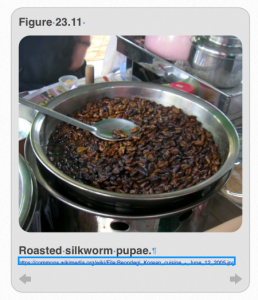
Stroll the market streets in China or Korea and help yourself to nicely roasted silkworm pupae (Figure 23.11). Or add a little zest by baking them with Satay sauce and rice. Silkworms are good for many occasions including as a simple pop-it-in-your-mouth snack. Silkworm sushi is also an inspired choice. Go on, give it a try! And if it makes you thirsty, you can wash it down with rice wine that has been steeped in ants. The ant wine is thought to be a good therapeutic agent against hepatitis B and rheumatism. The ant species are carefully chosen to have the most formic acid.
In Japan, you can grab a bunch of larvae from a river or stream and cook them up. The caddisfly larvae are one aquatic treat; another is the alderfly, or megaloptera, which is even larger and more valued. These insects live only in clean water and are used as a sign that the water is relatively pristine and unpolluted.
“I eat them like fish” said the chef in Bali, Indonesia as he worked up his special dragonfly dish. After frying and dressing with Zatarains’s sauce, each dragonfly was served atop a cushion of rice (Figure 23.12). What presentation! You can’t go wrong here. And if that doesn’t strike your palette, there’s always the sago-palm grub. These are actually the larvae of the Capricorn Beetle. The larvae are described as white and plump. They are juicy and just burst into your mouth when you bite into them. These insects can actually be farmed by cutting down the sago palm and making it easier for the beetles to bore into them to lay their eggs. Six weeks later, the larvae are big enough to harvest (Figure 23.13). Yum!
Who could resist a grasshopper tortilla? These chapulines, or grasshoppers, are delicious in tacos or on their own as a quick snack (Figure 23.14). Throw in a little avocado and you have a meal. They are very popular in Oaxaca, Mexico where they are consumed on a daily basis. Mealworms are also a local favorite. They are said to be quite tasty when mixed with spaghetti (Figure 23.15). There’s nothing better than chiro (hammerhead beetle larvae) wrapped in banana leaves. Not only can you hold the larvae more easily but it adds another food group as well. This entomophagy thing leads to all sorts of good habits.
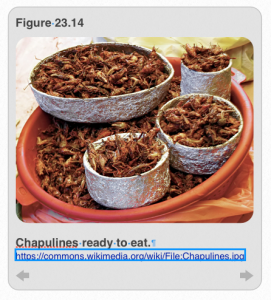
Next up, we go to South Africa where termite soldiers provide a delicious way to express your culinary creativity (Video 23.2). The soldiers can be collected and fried, roasted or eaten ground and baked into bread.Not only is this a versatile bug, but if you eat it, it won’t be around to eat your house.
Thailand calls with bamboo larvae (Figure 23.16). The insect bores into the bamboo and after 45–60 days, the larvae will enter an internode in the bamboo with an exit hole. The larvae then enter a period of diapause, or prolonged dormancy, that can extend for up to eight months. Even better, large numbers of larvae can collect in a single internode making them easy to harvest in large numbers. Nutritionally, the larvae consist of about 26% protein and 51% fat. They are not for dieters, made less so by the fact that they are generally deep fried in additional fat. Obviously, they could make it on the U.S. county fair circuit if they could be mounted on a stick.
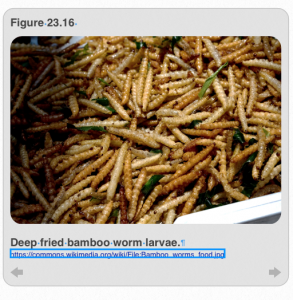
And taking it to the street in Canada, courtesy of the Montreal Insectarium, is a multicourse arthropod meal. Who could say no to General Tao’s silkworm chrysalises or glazed black ant cakes? Sounds like just the thing to meet the North American palate half way.
If you want to venture into the world of entomophagy, you are not left unprovisioned. There are some pretty good books and even some magazines that reveal the secrets of cooking with insects, where to find the insects you’re interested in eating, and how to best prepare them. Bon Appetit!
References
Chapter 23 Cover Photo: Cricket pasta. CC0 Public Domain: Pexels. Accessed via pixabay.com
Figure 23.1: Cover of FAO report. Edible insects: Future prospects for food and feed security. Food and Agriculture Organization of the United Nations. Rome, 2013. Accessed via http://www.fao.org/docrep/018/i3253e/i3253e00.htm
Figure 23.2: Distribution of hunger in the world. Figure 2 from: FAO, IFAD and WFP. 2015. The State of Food Insecurity in the World 2015. Meeting the 2015 international hunger targets: taking stock of uneven progress. Rome, FAO. http://www.fao.org/3/a-i4646e.pdf
Figure 23.3: Global human populations. CC BY-SA 3.0: Junuxx at en.wikipedia. Accessed via https://commons.wikimedia.org/wiki/File%3ACountries_and_regions_by_population_density.png
Figure 23.4: Human world population projections. CC0 Public Domain: El T. Accessed via https://commons.wikimedia.org/wiki/File:Population_curve.svg
Figure 23.5: Interdependency of producers and consumer. By W. S. Klooster, using public domain images.
Figure 23.6: Food web. By W. S. Klooster, using public domain images.
Figure 23.7: Water requirements to produce biomass. CC-BY: Loch Ness Water Gardens. Accessed via http://www.lochnesswatergardens.com/pondblog/how-much-water/
Figure 23.8a: Honeypot ants. CC-BY 2.5: Greg Hume (Greg5030). Accessed via https://commons.wikimedia.org/wiki/File:HoneyAnt.jpg
Figure 23.8b: Witchetty grubs. CC-BY-SA 3.0: Sputnikcccp. Accessed via https://commons.wikimedia.org/wiki/File:Witchetty_grub.jpg
Figure 23.9: Mopane worms. CC-BY-SA 3.0: ComQuat. Accessed via https://commons.wikimedia.org/wiki/File:Mopane-Raupen_gekocht.JPG
Figure 23.10: Cooked cicadas. Copyright: Peter Menzel. Available at http://www.sciencephoto.com/media/368090/view
Figure 23.11: Roasted silkworm pupae. CC-BY 3.0: Nesnad. Accessed via https://commons.wikimedia.org/wiki/File:Beondegi_Korean_cuisine_-_June_12_2005.jpg
Figure 23.12: Dragonflies on rice. Copyright: Peter Menzel. Available at http://www.sciencephoto.com/media/368244/view
Figure 23.13: Sago-palm grubs. Copyright: Peter Menzel. Available at http://menzelphoto.photoshelter.com/image/I0000qCSqxDM7XgU
Figure 23.14: CC-BY-SA 3.0: Meutia Chaerani / Indradi Soemardjan http://www.indrani.net. Accessed via https://commons.wikimedia.org/wiki/File:Chapulines.jpg
Figure 23.15: Mealworm spaghetti. Copyright: Peter Menzel. Available at http://menzelphoto.photoshelter.com/image/I000070qLCbJbMGo
Figure 23.16: Deepfried bamboo worm larvae. CC-BY-SA 2.0: Charles Haynes. Accessed via https://commons.wikimedia.org/wiki/File:Bamboo_worms_food.jpg
Video 23.1: Chimpanzees fishing for termites. Available on YouTube at https://www.youtube.com/watch?v=SI9vgrc5yVo
Video 23.2: Termites being prepared for consumption. Available on YouTube at https://www.youtube.com/watch?v=KjZK5y4fJ3Q
Table 23.1: Nutritional value of cow vs. grasshopper. Data compiled by S. W. Fisher, from various sources.
Additional Readings
Gordon, D.G. (2013). The Eat-a-Bug Cookbook, Revised: 40 Ways to Cook Crickets, Grasshoppers, Ants, Water Bugs, Spiders, Centipeded and Their Kin. Ten Speed Press, 136 pages.
Martin, D. (2014). Edible: An Adventure into the World of Eating Insects and the Last Great Hope to Save the Planet. New Harvest Publishing, 272 pages.
Van Huis, A., J. Itterbeeck, H. Klunder, E. Metens, A. Halloran, G. Muir and P. Vantomme (2012). FAO Edible Insects: Future Prospects for Food and Feed Security. FAO Forestry Paper 171.